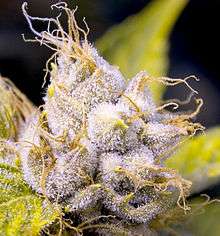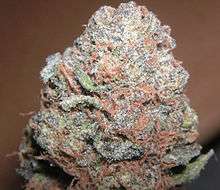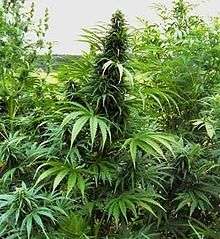Cannabis strains

Cannabis strains are either pure or hybrid varieties of Cannabis, typically of C. sativa, C. indica and C. ruderalis. Varieties are developed to intensify specific characteristics of the plant, or to differentiate the strain for the purposes of marketing or to make it more effective as a drug. Variety names are typically chosen by their growers, and often reflect properties of the plant such as taste, color, smell, or the origin of the variety. Cannabis strains commonly refer to those varieties with recreational and medicinal use. These varieties have been cultivated to contain a high percentage of cannabinoids. Several varieties of Cannabis, known as hemp, have a very low cannabinoid content, and are instead grown for their fiber and seed.
Types of varieties
- Clone-only variety – The grower may distribute genetically identical clones of the plant. A clone is the only way to propagate a plant while retaining its exact genetic makeup. Nevertheless, the conditions under which the plant is grown will still greatly affect the final product.
- Stable seed variety – Creating a genetically stable variety involves selectively choosing male and female cannabis plants and breeding them over the course of multiple generations. The final generation's seeds reliably grow into plants that exhibit the desired characteristics, though some genetic variation will still occur.
- Unstable seed varieties – Unstable varieties are produced without numerous generations of breeding. Although they can be produced quickly, plants grown from these seeds may have widely varying characteristics. Commercial seed retailers generally do not distribute unstable seed varieties, though some disreputable shops might. Amateur and third-party growers may, whether knowingly or not, produce unstable derivatives from well known varieties and misleadingly call them by their true variety name.
- Wild varieties or landraces – Some varieties, such as Colombian and Thai, refer to Cannabis plants found growing wild in certain regions. Typically, these plants are used as bases for the production of more specialized varieties, such as G-13, or Hash.
Major variety types

The two species of the Cannabis genus that are most commonly grown are Cannabis indica and Cannabis sativa.[1] A third species, Cannabis ruderalis is very short and produces only trace amounts of tetrahydrocannabinol (THC), and thus is not commonly grown for industrial, recreational or medicinal use. However, because Cannabis ruderalis flowers independently of the photoperiod and according to age, it has been used to breed autoflowering strains.[2]
Pure sativas are relatively tall (reaching as high as 4.5 meters), with long internodes and branches, and large, narrow-bladed leaves. Pure indica varieties are shorter and bushier, have wider leaflets. They are often favored by indoor growers for their size. Sativas bloom later than indicas, often taking a month or two longer to mature. The subjective effects of sativas and indicas are said to differ, but the ratio of tetrahydrocannabinol (THC) to cannabidiol (CBD) in most named drug varieties of both types is similar (averaging about 200:1). Unlike most commercially developed strains, indica landraces exhibit plants with varying THC/CBD ratios.[3] Avidekel, a medical marijuana strain developed in Israel, has a very low content of THC but a high content of CBD, limiting its recreational value but maximizing medical effect.[4]
There has been a recent movement to characterize strains based on their reported subjective effects. For example, WoahStork has used machine learning algorithms to classify strains into 6 Distinct Activity groups.[5]
It is impossible for a hermaphrodite to create any male only plants. A hermaphrodite may create female only seeds and hermaphrodite seeds. Also the female only seeds may carry the hermaphrodite trait.[6]
Breeding
In addition to pure indica, sativa, and ruderalis varieties, hybrid varieties with varying ratios of these three types are common. For example, the White Widow hybrid containing about 60% indica and 40% sativa ancestry. These hybrid varieties exhibit traits from both parental types. There are also commercial crossbred hybrids which contain a mix of both ruderalis, indica and/or sativa genes, and are usually autoflowering varieties. These varieties are bred mostly for the medicinal cannabis market, since they are not very appreciated by recreational cannabis users because ruderalis varieties are lower in THC and impart a slightly unpleasant taste. "Lowryder" was an early auto-flowering hybrid that retained the flowering behavior of ruderalis plants, while also producing appreciable amounts of THC and CBD. Autoflowering cannabis varieties have the advantage of being discreet due to their small stature. They also require shorter growing periods, as well as having the additional advantage that they do not rely on a change in the photoperiod to determine when to flower.
Breeding requires pollinating a female cannabis plant with male pollen. Although this occurs spontaneously and ubiquitously in nature, the intentional creation of new varieties typically involves selective breeding in a controlled environment.
When cannabis is cultivated for its psychoactive or medicinal properties, male plants will often be separated from females. This prevents the fertilization of the female plants, either to facilitate sinsemilla flowering or to provide more control over which male is chosen. Pollen produced by the male is caught and stored until it is needed.
When a male plant of one strain pollinates a female of another strain, the seeds will be F1 hybrids of the male and female. These offspring will not be identical to their parents. Instead, they will have characteristics of both parents. Repeated breeding results in certain characteristics appearing with greater regularity.
A common technique to stabilize a cannabis variety is called "cubing". A breeder seeking specific traits in the hybrid offspring (for example, greater resin production or tighter node spacing) will breed hybrid plants most exemplifying these characteristics with a parent plant. The same traits are sought in the new inbred offspring, which are then again bred with the original parent plant. This process is called cubing because it usually repeated across three, or possibly more generations before the variety's genetics are acceptably stable.
Varieties
In a retail market that is decriminalised such as in The Netherlands, (wholesale production is illegal but prosecutions are not always enforced because of the contradiction of the law that is recognised by the courts[7]), competition puts pressure on breeders to create increasingly attractive varieties to maintain market share. Breeders give their strains distinct and memorable names in order to help differentiate them from their competitors' strains, although they may in fact be very similar.
Popular strains are incorporated into new hybrids, which often bear a similar name to their parent. This phenomenon has occurred with Haze and Sour varieties, amongst others.
Black-market cannabis dealers sometimes claim their products are of a certain strain to capitalise on that strains success or reputation.
Acapulco Gold
Acapulco Gold is a golden-leafed Cannabis sativa strain originally from the Acapulco area of southwest Mexico.[8][9][10]
Bedrocan
Bedrocan is a Dutch medical marijuana strain, having a standardized content of THC (22%) and CBD (1%). It is cultivated by the company of the same name. It was first introduced in 2003 and is dispensed through pharmacies after prescription from a physician.
The Dutch Office of Medicinal Cannabis (OMC) was founded in 2001. A single cultivator, selected by the OMC, cultivates the cannabis. The quality of each batch is analysed according to an analytical monograph formulated by the National Institute for Public Health and Environment. Specifications to be complied with, besides THC and CBD content, include the absence of pesticides and heavy metals and adequate microbiological purity.[11] The product is sterilized shortly after harvest by gamma radiation (dose < 10 kGy) and subsequently packaged under aseptic conditions.[12] The number of patients prescribed legal medicinal cannabis is much lower than anticipated, and the majority of patients still frequented the illegal circuit.[11]
Purple Kush

Purple Kush is a 100% Indica strain of Cannabis. This plant, "forms a short squat bush with very dense internodes and large fan leaves, staying in the 60 to 90 cm (2 to 3 ft) height range while grown indoors. Purple Kush's foliage exhibits a classic indica growth pattern: a sturdy bush with dark green hues and sometimes hints of purple toward ripeness."[13]
Skunk
Skunk refers to Cannabis strains that are strong-smelling and have been likened to the smell of the spray from a skunk. These strains of cannabis are believed to have originated in the United States prior to development by Dutch growers.[14] Just as with other strains of cannabis, skunk is commonly grown in controlled indoor environments under specialized grow lights, or in a greenhouse when full outdoor conditions aren't suitable; skunk strains are hybrids of Cannabis sativa and Cannabis indica.[15]
Skunk strains typically have a 14 to 15% THC concentration.[16]
Tom Cruise Purple
Tom Cruise Purple is a strain of cannabis sold in California by select licensed cannabis clubs. The strain is potent, and is packaged with a picture of the actor Tom Cruise laughing. Tom Cruise Purple is sold by cannabis purveyors in Northern California.[17] Cruise sought out legal advice regarding the product, and considered a lawsuit against its manufacturers.[18][19][20][20][21][22][23][24]
See also
References
- ↑ Small, E. and A. Cronquist. 1976. A practical and natural taxonomy for Cannabis. Taxon 25(4): 405–435.
- ↑ Greg Green (2001). The Cannabis Grow Bible (4th ed.). p. 47.
- ↑ Hillig, Karl W. and Paul G. Mahlberg. 2004. A chemotaxonomic analysis of cannabinoid variation in Cannabis (Cannabaceae). American Journal of Botany 91(6): 966-975. Retrieved on 22 February 2007
- ↑ Halverson, Nic (July 6, 2012). "Marijuana That Doesn't Get You Stoned". Discovery Channel. Discovery Communications, LLC. Retrieved January 23, 2014.
- ↑ Reggente, Nicco (February 15, 2016). "WoahStork's Strain Activity Groups". WoahStork. WoahStork. Retrieved March 15, 2016.
- ↑ http://www.kindgreenbuds.com/cannabis-grow-bible/selfing/
- ↑ http://phys.org/news/2014-10-dutch-court-illegal-cannabis-growers.html
- ↑ Partridge, Eric (2006). The New Partridge Dictionary of Slang and Unconventional English: A-I. Taylor & Francis. p. 4. ISBN 978-0-415-25937-8.
- ↑ Central Intelligence Agency (13 December 2013). The CIA World Factbook 2012. Skyhorse Publishing Company, Incorporated. p. 44. ISBN 978-1-62873-181-1.
- ↑ Green, Jonathon (2 October 2013). Dictionary of Jargon. Routledge. p. 4. ISBN 978-1-317-90818-0.
- 1 2 Frederike K. Engels; Floris A. de Jong; Ron H.J. Mathijssen; Joëlle A. Erkens; Ron M. Herings; Jaap Verweij (2007), "Medicinal cannabis in oncology", European Journal of Cancer, 43: 2638–2644, doi:10.1016/j.ejca.2007.09.010
- ↑ Arno Hazekamp (2006), "An evaluation of the quality of medicinal grade cannabis in the Netherlands" (PDF), Cannabinoids, 1 (1): 1–9
- ↑ Rosenthal, Ed (2007). More Marijuana Varieties from the World's Great Seed Breeders, p.134. ISBN 9780932551795.
- ↑ "Skunk". Retrieved 11 November 2015.
- ↑ http://www.drugscope.org.uk/resources/drugsearch/drugsearchpages/skunkk
- ↑ Skunk’s psychosis link is only half the cannabis story PMID 10641915
- ↑ Krugman, Milt (April 8, 2008). "Tom Cruise fuming". Bucks County Courier Times. Levittown, Pennsylvania.
- ↑ "Lanzan producto de marihuana con la imagen de Cruise". Esmas.com (in Spanish). www.esmas.com. April 13, 2008. Retrieved March 25, 2010.
- ↑ "Tom Cruise 'goes to pot' over marijuana link". The New Zealand Herald. APN News & Media. April 7, 2008.
- 1 2 "Medical high jinks leave Tom Cruise camp fuming". New York Daily News. Mortimer Zuckerman. April 4, 2008. Retrieved March 25, 2010.
- ↑ Reardanz, Karen (April 4, 2008). "Cruise Fumes Over Marijuana Association". San Francisco Chronicle. Retrieved March 25, 2010.
- ↑ Saar, Mayrav (April 4, 2008). "TomKat in a Huff over Tom Pot". E! Online. E! Entertainment Television, Inc. Retrieved March 25, 2010.
- ↑ WENN (April 4, 2008). "Cruise fumes over marijuana association". World Entertainment News Network. Comtex.
- ↑ "Report: 'Tom Cruise Purple' Medical Marijuana Has Actor Smoking Mad". Fox News Channel. Fox News Network, LLC. April 4, 2008. Retrieved March 25, 2010.
External links
| Wikimedia Commons has media related to Cannabis by strain. |
- Sawler, Jason; Stout, Jake M.; Gardner, Kyle M.; Hudson, Darryl; Vidmar, John; Butler, Laura; Page, Jonathan E.; Myles, Sean (26 August 2015). "The Genetic Structure of Marijuana and Hemp". PLoS ONE. 10 (8). doi:10.1371/journal.pone.0133292. ISSN 1932-6203. PMC 4550350
 .
.


